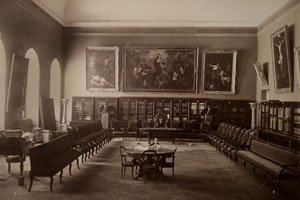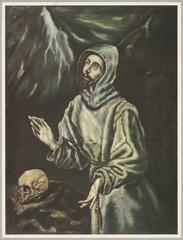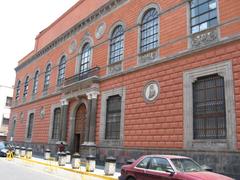
Academy of San Carlos Mexico City: Visiting Hours, Tickets, and Historical Guide
Date: 14/06/2025
Introduction: History and Cultural Significance
Located in the heart of Mexico City’s historic center, the Academy of San Carlos (Academia de San Carlos) stands as a beacon of Mexican and Latin American art. Established in the late 18th century, it was the first major art academy and museum in the Americas, pioneering formal European-style art education in New Spain. Over centuries, it has nurtured renowned artists such as Diego Rivera and José Clemente Orozco, and remains a vital institution for art education and preservation. Today, its impressive neoclassical architecture, extensive collections, and dynamic cultural initiatives make it an essential destination for art lovers and history enthusiasts.
For the most current information, consult the Academy of San Carlos website.
Table of Contents
- Introduction: History and Cultural Significance
- Visiting Hours and Ticket Information
- Location and Accessibility
- Architectural and Artistic Highlights
- Guided Tours and Special Events
- Nearby Attractions and Dining
- Historical Overview
- Visitor Facilities and Tips
- Frequently Asked Questions (FAQ)
- Conclusion and Recommendations
- References
Visiting Hours and Ticket Information
- Hours: Tuesday to Sunday, 10:00 AM – 6:00 PM
- Closed: Mondays and select public holidays
- General Admission: ~50 MXN (approx. $2.50 USD)
- Discounts: Available for students, teachers, seniors; children under 12 and visitors on Sundays often enter free
- Tickets: Purchase at the entrance or online via the official website. Booking ahead is recommended during peak periods.
Location and Accessibility
- Address: Calle Academia 22, Centro Histórico, Cuauhtémoc, C.P. 06060, Mexico City (Google Maps)
- Transport:
- Metro: Bellas Artes (Lines 2 & 8), Allende (Line 2)
- Bus: Multiple routes serve the area
- Taxis and ride-sharing readily available
- Accessibility: Most public spaces are wheelchair-accessible, though some upper galleries may be difficult to access due to the building’s historic structure. Contact ahead for specific needs (UNAM Accessibility Guide).
Architectural and Artistic Highlights
- Neoclassical Façade: The building, originally the Real Hospital del Amor de Dios, was adapted in 1791 and later remodeled by Javier Cavallari with an Italian Renaissance façade and an Art Nouveau dome.
- Permanent Collections:
- Classical sculptures and engravings from the late 18th century
- Paintings by notable alumni (e.g., Diego Rivera, José Clemente Orozco, José María Velasco)
- Exhibitions tracing Mexican art from the Enlightenment to the muralist movement
- Sculpture Courtyard: A tranquil open-air space adorned with classical and modern works.
Guided Tours and Special Events
- Guided Tours: Available in Spanish and occasionally English. Book in advance via the official website.
- Special Events:
- Rotating exhibitions, student showcases, and retrospectives
- Workshops, lectures, and cultural performances
- Updated events calendar at the Academia de San Carlos events page.
Nearby Attractions and Dining
- Cultural Landmarks:
- Palacio de Bellas Artes (official site)
- Museo Nacional de Arte (MUNAL) (MUNAL)
- Alameda Central Park
- Dining:
- Café de Tacuba (official site)
- El Cardenal (official site)
Historical Overview
Foundations and Enlightenment Origins
Founded in 1781 as the School of Engraving and inaugurated in 1785 as the Real Academia de las Nobles Artes de San Carlos, the Academy introduced formal European art education to New Spain. Its Enlightenment roots are reflected in its curriculum and architectural design.
Architectural Evolution
The Academy’s home, a repurposed 16th-century hospital, was remodeled in the late 18th and early 19th centuries. Its neoclassical architecture set a standard for institutional buildings in Mexico.
Academic Influence
The Academy replaced the guild system and emphasized classical training—drawing, anatomy, perspective—shaping generations of Mexican artists and architects.
Post-Independence and Modernization
Following Mexican independence, the Academy adapted to new political and cultural realities, integrating Mexican themes and participating in national cultural policy. By 1910, it became part of UNAM, embracing modern art currents and playing a crucial role in the rise of Mexican muralism.
Contemporary Role
Today, the Academy is a vibrant educational and cultural hub, hosting exhibitions, maintaining archives, and continuing its legacy as a center for artistic innovation.
Visitor Facilities and Tips
- Restrooms: Accessible and well-maintained
- Cloakroom: Limited space for bags and coats
- Gift Shop: Art books, prints, and souvenirs
- Accessibility: Main galleries are wheelchair-friendly; some upper floors may be less accessible
- Photography: Allowed without flash in most areas. Restrictions apply to some temporary exhibitions
- Best Times to Visit: Weekday mornings for fewer crowds
- Safety: The historic center is generally safe during the day; watch for pickpockets
- Duration: Plan 1–2 hours to explore fully
- Sustainability: The Academy promotes recycling and responsible tourism (UNAM Sustainability)
Frequently Asked Questions (FAQ)
Q: What are the visiting hours?
A: Tuesday to Sunday, 10:00 AM – 6:00 PM; closed Mondays and major holidays.
Q: How much are tickets?
A: ~50 MXN for general admission; discounts for students, teachers, seniors; free for children under 12 and on Sundays.
Q: Is the Academy accessible for wheelchair users?
A: Most main areas are accessible, but some upper galleries may be challenging.
Q: Are guided tours available?
A: Yes, in Spanish and sometimes English. Advance booking recommended.
Q: Can I take photographs inside?
A: Yes, for personal use without flash. Restrictions may apply in temporary exhibitions.
Q: What are nearby attractions?
A: Palacio de Bellas Artes, Museo Nacional de Arte, Alameda Central, and many historic sites.
Conclusion and Final Recommendations
The Academy of San Carlos offers an immersive journey into Mexico’s artistic and cultural history, blending neoclassical architecture with world-class art collections. Its accessible location, affordable entry, and robust programming make it an essential stop for travelers and locals alike. Plan your visit by checking the latest hours and ticket policies on the official Academy website, and enhance your experience by joining guided tours or attending special events.
For deeper cultural exploration, pair your visit with nearby museums and historic sites. Download the Audiala app for interactive guides and event updates, and follow official channels for ongoing news and visitor tips.












































































































































































